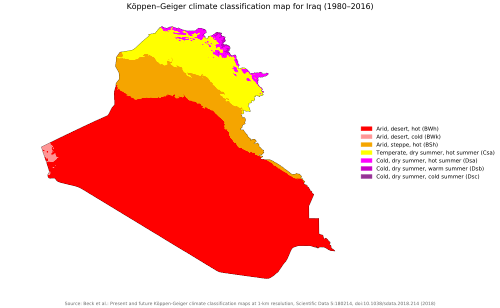Climate change in Iraq
Climate change in Iraq is resulting in effects that are making Iraq's environmental, security, political, and economic challenges worse. Rising temperatures, intense droughts, declining precipitation, desertification, salinization, and the increasing prevalence of dust storms have undermined Iraq’s agricultural sector. Additionally, Iraq’s water security is based on the declining Tigris–Euphrates river system. National and regional political uncertainty will make mitigating the effects of climate change and addressing transnational water management very difficult. Climatic changes such as increasing temperatures, reduced precipitation, and increasing water scarcity will likely have serious implications for the state of Iraq for years to come.[1] Greenhouse gas emissions per person are above the world average.[2]
Greenhouse gas emissions[]
In 2019 Iraq accounted for 8% of world methane emissions,[3] and 0.5% of world carbon dioxide emissions.[4] Greenhouse gas emissions per person are above the world average.[2]
Impacts on the natural environment[]
Temperature and weather changes[]
In Iraq, climate change has resulted in "prolonged heat waves, erratic precipitation, higher than average temperatures and increased disaster intensity,” according to a 2018 report by the Expert Working Group on Climate-related Security Risk.[5]
Baghdad is experiencing an earlier onset of 48C days.


Extreme weather events[]
Drought between 2007 and 2009 was followed by very heavy rains which contributed to flooding and soil loss.[6]
Water resources[]
As water levels fall, increasing salinity of the water supply has become a concern in southern Iraq, especially in Basra.[5]
Impacts on people[]
Economic impacts[]
In 2019, air conditioning has become unaffordable or impossible to maintain for lower income residents, due to erratic electricity supplies.[7]
Agriculture[]
Iraq's years of drought became especially acute in 2018, at which time its land under cultivation was reduced by half. Cultivation of irrigated crops such as rice, corn and other cereals was suspended by the government; losses in rice production were estimated at 39 million dollars.[8]
In 2019, an unusually wet winter "restored freshwater marshes of southern Iraq," and also caused widespread flooding on the Tigris and Euphrates rivers.[9]
Society and culture[]
Security risks[]
When agricultural livelihoods are disrupted, local residents in ISIS-liberated areas may become dependent on terrorist groups for access to resources.[10]
Demonstrations and clashes over water rights have occurred in southern Iraq.[10]
See also[]
- Climate of Iraq
External links[]
- UNFCCC Iraq documents
- Nationally Determined Contributions
- Iraq emissions at Climate Trace
- Live carbon emissions from electricity generation
- Methane map
References[]
- ^ USAID. "Climate Risk Profile: Iraq". Climatelinks. Retrieved 2019-08-10.
- ^ a b "CO2 emissions". Our World in Data. Retrieved 2021-01-21.
- ^ "Iraq mulls tackling its methane problem and reaping major benefits along the way". www.uniraq.org. Retrieved 2021-01-21.
- ^ Ritchie, Hannah; Roser, Max (2020-06-11). "CO₂ and Greenhouse Gas Emissions". Our World in Data.
- ^ a b Cooke, Kieran (12 Nov 2018). "Iraq's climate stresses are set to worsen". PreventionWeb. Retrieved 2019-08-10.
- ^ UN Inter-Agency Information and Analysis Unit (June 2012). "Climate Change in Iraq" (PDF). ReliefWeb. Retrieved 2019-08-10.
- ^ Hall, Richard (2019-08-10). "Here, only the rich can escape the unbearable heat. Soon, thanks to climate change, it will be everywhere". The Independent. Retrieved 2019-08-10.
- ^ Agence France-Presse. "Iraq's cultivated areas reduced by half as drought tightens grip". The National. Retrieved 2019-08-10.
- ^ "Rains Test Iraq in Era of Climate Change". Voice of America. May 2, 2019. Retrieved 2019-08-10.
- ^ a b Expert Working Group on Climate-related Security Risk (August 2018). "Iraq: Climate-related Security Risk Assessment" (PDF). pp. 1–2.
![]() This article incorporates public domain material from the United States Government document: "[1], USAID".
This article incorporates public domain material from the United States Government document: "[1], USAID".
- Climate change in Iraq
- Climate of Iraq
- Environment of Iraq
- Climate change by country